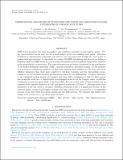Files in this item
Observational signatures of transverse magnetohydrodynamic waves and associated dynamic instabilities in coronal flux tubes
Item metadata
| dc.contributor.author | Antolin, Patrick | |
| dc.contributor.author | De Moortel, Ineke | |
| dc.contributor.author | Doorsselaere, Tom Van | |
| dc.contributor.author | Yokoyama, Takaaki | |
| dc.date.accessioned | 2017-02-09T11:30:20Z | |
| dc.date.available | 2017-02-09T11:30:20Z | |
| dc.date.issued | 2017-02-22 | |
| dc.identifier | 249105943 | |
| dc.identifier | a46d5cd5-cbab-499e-a35f-ae33206a8b9c | |
| dc.identifier | 85014330144 | |
| dc.identifier | 000395870900012 | |
| dc.identifier.citation | Antolin , P , De Moortel , I , Doorsselaere , T V & Yokoyama , T 2017 , ' Observational signatures of transverse magnetohydrodynamic waves and associated dynamic instabilities in coronal flux tubes ' , Astrophysical Journal , vol. 836 , no. 2 , 219 , pp. 1-23 . https://doi.org/10.3847/1538-4357/aa5eb2 | en |
| dc.identifier.issn | 0004-637X | |
| dc.identifier.other | ArXiv: http://arxiv.org/abs/1702.00775v1 | |
| dc.identifier.other | ORCID: /0000-0002-1452-9330/work/39526523 | |
| dc.identifier.uri | https://hdl.handle.net/10023/10256 | |
| dc.description | This research has received funding from the UK Science and Technology Facilities Council and the European Union Horizon 2020 research and innovation programme (grant agreement No. 647214), and also from JSPS KAKENHI Grant Numbers 25220703 (PI: S. Tsuneta) and 15H03640 (PI: T. Yokoyama). T.V.D. was supported by FWO Vlaanderen’s Odysseus programme, GOA-2015-014 (KU Leuven) and the IAP P7/08 CHARM (Belspo). | en |
| dc.description.abstract | Magnetohydrodynamic (MHD) waves permeate the solar atmosphere and constitute potential coronal heating agents. Yet, the waves detected so far may be but a small subset of the true existing wave power. Detection is limited by instrumental constraints but also by wave processes that localize the wave power in undetectable spatial scales. In this study, we conduct 3D MHD simulations and forward modeling of standing transverse MHD waves in coronal loops with uniform and non-uniform temperature variation in the perpendicular cross-section. The observed signatures are largely dominated by the combination of the Kelvin–Helmholtz instability (KHI), resonant absorption, and phase mixing. In the presence of a cross-loop temperature gradient, we find that emission lines sensitive to the loop core catch different signatures compared to those that are more sensitive to the loop boundary and the surrounding corona, leading to an out-of-phase intensity and Doppler velocity modulation produced by KHI mixing. In all of the considered models, common signatures include an intensity and loop width modulation at half the kink period, a fine strand-like structure, a characteristic arrow-shaped structure in the Doppler maps, and overall line broadening in time but particularly at the loop edges. For our model, most of these features can be captured with a spatial resolution of 0″33 and a spectral resolution of 25 km s−1, although we do obtain severe over-estimation of the line width. Resonant absorption leads to a significant decrease of the observed kinetic energy from Doppler motions over time, which is not recovered by a corresponding increase in the line width from phase mixing and KHI motions. We estimate this hidden wave energy to be a factor of 5–10 of the observed value. | |
| dc.format.extent | 23 | |
| dc.format.extent | 7637768 | |
| dc.language.iso | eng | |
| dc.relation.ispartof | Astrophysical Journal | en |
| dc.subject | Magnetohydrodynamics (MHD) | en |
| dc.subject | Sun: activity | en |
| dc.subject | Sun: corona | en |
| dc.subject | Sun: filaments, prominences | en |
| dc.subject | Sun: oscillations | en |
| dc.subject | QB Astronomy | en |
| dc.subject | QC Physics | en |
| dc.subject | NDAS | en |
| dc.subject | BDC | en |
| dc.subject | R2C | en |
| dc.subject.lcc | QB | en |
| dc.subject.lcc | QC | en |
| dc.title | Observational signatures of transverse magnetohydrodynamic waves and associated dynamic instabilities in coronal flux tubes | en |
| dc.type | Journal article | en |
| dc.contributor.sponsor | Science & Technology Facilities Council | en |
| dc.contributor.sponsor | Science & Technology Facilities Council | en |
| dc.contributor.sponsor | European Research Council | en |
| dc.contributor.institution | University of St Andrews. Applied Mathematics | en |
| dc.identifier.doi | https://doi.org/10.3847/1538-4357/aa5eb2 | |
| dc.description.status | Peer reviewed | en |
| dc.identifier.grantnumber | N/A | en |
| dc.identifier.grantnumber | ST/N000609/1 | en |
| dc.identifier.grantnumber | 647214 | en |
This item appears in the following Collection(s)
Items in the St Andrews Research Repository are protected by copyright, with all rights reserved, unless otherwise indicated.

